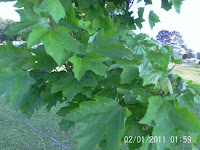All writers, from one that writes a high-school essay to the veteran novelist, need depth, color, and background to make their story stand out. I love to throw in either magnificant trees or showy flowers to liven up my scenes. I've written about flowers the last two weeks, so this week I'll introduce a broadleaf tree. You can’t go wrong with the red maple, especially if your story takes place in the northeast. This week I decided to list a ton of fun facts about the red maple to strengthen any tale, from comedy to historical.
 |
| Leaves of my red maple |
Did you know…
The red maple is the state tree of Rhode Island?
The red maple is used commercially on a small scale for maple syrup production?
The red maple yields medium to high quality lumber?
The red maple is best known for its deep scarlet foliage in autumn?
The largest known living red maple is located in Michigan and is 125 feet high?
The red maple is one of the most abundant and widespread trees in eastern North America?
The red maple can live up to 150 years?
The red maple is used as a food source by elk, white-tailed deer, and some species of butterflies and moths?
The leaves of red maple, especially when dead or wilted, are extremely toxic to horses?
Story ideas abound. A maple syrup romance. A historical centered around the largest red maple, destined by our villain for firewood. A suspense where horses are fed red maple leaves. So friend, the next time you take pen in hand, consider the red maple, and let your imagination take root. J
Our writing prompt for the week: He grasped the lowest branch of the stately red maple, and tugged until…
Flowers of the Midwest
Michigan lily
Prairie ragwort
Indian blanket
Evening primrose
Prairie smoke
Prairie mimosa
Yellow goat beard
White prickly poppy
Blue wild indigo
Midwestern Flowering Vines & Parasitic Plants
Passionflower
Black-eyed Susan vine
Redberry moonseed
Black dog-strangling vine
Trees-Broadleaf
Box elder
Japanese maple
Red maple
Baobab
White Birch
Red gum
Common beech
Weeping fig
Sycamore
Red/White oak
Teak
Mountain Elm

No comments:
Post a Comment